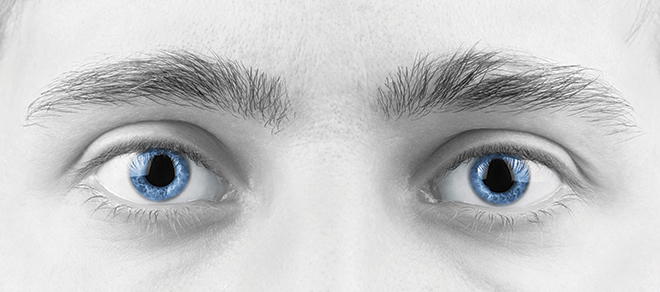
By Lisa Peten
Many people eat fruits and vegetables, take vitamins and minerals and live healthy lifestyles to ensure good health. By all accounts, these are excellent ways to maintain weight and promote disease-free living. However, most people may not realize the profound effect these practices have directly on visual health. Similar to weight loss, it is not possible to direct enhanced health to specific parts of the body, however, consistent consumption of fruits and vegetables, adequate intake of vitamins and minerals and safe lifestyle practices all help preserve good visual health. With the focused gaze of an eagle’s eye, you too can maintain good vision and decrease the chance of declining vision.
Eat Veggies for Vision
“I make sure I get a lot of vegetables, a lot of fruit. I am a big fruit man; I am a vegetable man, anyway.” — Magic Johnson
In 2016, the National Health Interview Survey reported that 25.5 million American Adults reported experiencing vision loss. This figure is a call for more prevention methods to surface for enhanced eye care and safety. As an easy self-care strategy, good nutrition is a good habit with vegetables as the foundation. Vegetables that aid in vision care and maintenance include carrots, spinach, kale, bell peppers and sweet potatoes.
Carrots contain Vitamin A and beta carotene which help the surface of the eye and can also help prevent eye infections and other serious eye conditions. They can be eaten cooked or raw, as a snack or with a meal.
Spinach, kale, and other dark green leafy vegetables contain chlorophyll, which give plants their color. A study in the Journal of Food Science, which was published by the Institute of Food Technologists, found that these green vegetables increase visual performance and prevent age-related eye diseases. So, delight in the goodness of these greens in salads, smoothies or raw on sandwiches.
Lutein and zeaxanthin are carotenoids found in high amounts in bell peppers and the above green vegetables, may improve eye health with enormous consumption. Bell peppers are said to protect the human retina, the light-sensitive inner wall of the eye, from oxidative damage. Enjoy bell peppers in a variety of colors, raw or cooked, or dried or powdered as a seasoning.
Sweet potatoes are really helpful for eyes. The sweet potato helps to replenish blood and soothe the optic nerve. It can also improve the functioning of the optic nerve system, nourishing the retina and eyelids and also have some help in the treatment of cataracts and nyctalopia. The sweet potato is rich in dietary fiber, vitamins and minerals. There are various ways to prepare the sweet potato; you can eat it as a main dish or make it into a snack. Sweet potato powder can be dissolved in milk or a plant-based milk beverage. How is that for insight? (Pun intended.)
Give Fruits A Bite for Good EyeSight
“I try to eat fruit and be healthy.” — Lara Stone
According to a study by Tufts University, blueberries may help to reduce your risk of cataracts, glaucoma, heart disease, cancer, and other conditions. You can eat these raw or mixed with your favorite recipe.
According to Healthline.com, oranges can contribute to healthy blood vessels in your eyes and can combat the development of cataracts and age-related macular degeneration in combination with other vitamins and nutrients. Oranges can be a snack enjoyed anytime or in a salad.
View Vitamins’ Value
“Blueberries, strawberries, and broccoli are all high in vitamins.” — David Kirsch
Dr. Leland Carr, an optometrist and professor of optometry at Northeastern State University in Oklahoma was recently interviewed for an article written on eye health on VSP.com. Dr. Carr suggests getting at least three servings per week of vitamins from each of the groups below.
Vitamin A: carrots, kale, spinach, dairy products, egg yolks
Vitamin C: citrus fruits (especially kiwi fruit) and juices, green peppers, broccoli, potatoes
Vitamin E: eggs, whole grains, vegetable oils, sunflower seeds
Diminish the Myopic View of Minerals
“There is a world of difference between foods fortified with synthetic vitamins and minerals, and eating vegetables, fruit, and other whole foods full of vitamins and minerals in their natural form.” — Harley Pasternak
Dr. Andrew Weil is a well-known medical physician known for promoting an anti-inflammatory lifestyle to prevent and reverse functional and degenerative diseases. In guidance published on his website, he suggests that zinc is important for eye health, although the body only needs it in small quantities. Zinc can be found in common foods such as meat, dairy, shellfish, pumpkin and sunflower seeds, legumes, as well as whole grains. Selenium is another mineral to help protect the retina, aids cell development and acts as an antioxidant. It helps fight glaucoma and cataracts.
Your Lifestyle – Seeing is Believing
Both sedentary and active lifestyles require essential components to preserve and protect eye safety and health. Essentials listed below help to preserve and protect good vision while decreasing the onslaught of poor eye health.
- Sunglasses – While largely known for style and fashion, “shades” throw shade to your eyes in a good way. Be sure to purchase shades boasting UVA and UVB 100% protection to lessen overexposure from the sun’s rays.
- Screen Protection – Now more than ever we are viewing screens every second of every day via computers, tvs, phones, or watches. In an article titled “How to Keep Computer Screens from Destroying Your Eyes” author Lindsay Abrams recommends five keys to guard against eye strain, dry eyes, or blurred vision including ‘reminding yourself to blink’ and taking what experts call a “20-20-20 break;” every 20 minutes, give yourself 20 seconds to check out what’s going on 20 feet away from you.
- Clean Eyes – Outside of Hollywood, crying is not a game. It does, however, help you keep your eyes clean and clear. Researchers believe that crying could reduce the levels of chemicals in the body, which could, in turn, reduce stress, and thus increase the prevention of eye dis-eases. Ever heard of lysozyme? This fluid is in tears and contains powerful antimicrobial properties that help kill bacteria and keep the eyes clean.
- Eye Exercises – If the release of lysozyme still does not persuade you to enjoy the chore of cutting onions, perhaps eye exercises will. You do not need a gym and best of all you reduce your chances of glaucoma, all while improving your eyesight. Five exercises to relieve stress and rest your eyes include:
- Palming – Placing warm hands over your eyes
- Blinking – Rapid blinking with periods of rest
- Zooming – Extending your arm with your thumb up for a period of back and forth motions
- Shifting – Moving your eyes left to right
- Figure of Eight – Separately using left and right thumbs outstretched drawing the figure eight, each 10 times
Look at Your Lifestyle
“I learned in a very public setting what works and doesn’t work for a healthy lifestyle.” — Michael De Luca
If you do not have any issues with your eyesight, chances are you have your food, nutritional supplements and lifestyle to thank. Seeing is believing when it comes to good choices made to prevent vision decline. It is important to not take your eye health for granted. Learn to live well with a healthy lifestyle and diet to help make your ‘look-ing’ last as long as it should.
References
https://www.firmoo.com/answer/question/5239.html
https://www.healthline.com/health/eye-health/best-foods-for-eyes
https://www.vsp.com/eating-healthy.html
https://www.webmd.com/eye-health/features/how-to-pick-good-sunglasses#1
https://www.medicalnewstoday.com/articles/319631.php
https://www.hdfchealth.com/knowledge-center/health-and-living-guide/eye-exercises.aspx
https://www.weilvitaminadvisor.com/zinc_MF_baby
Lisa Peten, C.H.H.C. is a self-help hearing coach, mind-body empowerment speaker, and health advocate blogger on a mission to empower health-hungry communities to become more proactive in obtaining nourishing foods and seeking holistic health alternatives. Subscribe to Sound Health and Healing’s free newsletter to attune your vibrational settings for miraculous healing at www.soundhealthandhealing.com.
 Conscious Community Magazine Dedicated to Elevating Consciousness
Conscious Community Magazine Dedicated to Elevating Consciousness




